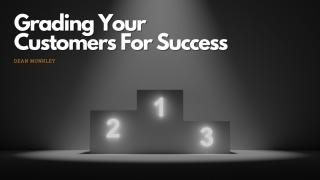
You're a smart business person, and I get it: the allure of "new business" often sends us on a quest for brand-new customers. But let me play devil's advocate for a moment: what if I told you the next big deal could come from someone you already know? That's right. Your existing customer base can be a goldmine for what we in the industry like to call "new old business" — new orders from familiar faces.
Start This By Grading Your Current Customers
I can already hear you say, "But grading customers? Isn’t that a bit too much?" Hear me out. Grading isn't about valuing one customer over another; it's about strategic alignment. It's the compass that points you toward the relationships deserving of your focus and resources. Plus, it helps you uncover new avenues for business development, from identifying the need for new accreditations to finding opportunities to invest in specialised machinery.
In a previous post, I delved into the key concepts of Total Available Market (TAM) and Potential Available Market (PAM). These principles are not just theoretical; they're practical tools that can significantly inform your customer engagement strategy. Imagine a client who spends £1 million each year on subcontract engineering services. If you're only capturing £100,000 of that, it begs the question: What's happening with the remaining £900,000?
Let's say you're a machinist, and you discover that out of the client's £1 million budget, £500,000 is allocated to machined components and the other £500,000 goes toward fabrication. In this scenario, your PAM isn't the full £1 million—it's £500,000. Understanding this nuance allows you to tailor your approach to better serve your client's needs and to grow your share of their spending more effectively.
By zeroing in on your PAM, you not only clarify your room for growth with each client, but you also set the stage for more meaningful, profitable interactions.
Crafting Your Ideal Customer Wishlist
The first step in grading customers is to create a customer "wishlist" of sorts. You can think about:
- The customer's annual spend on subcontract engineering.
- The types of materials they often require.
- Necessary accreditations for doing business with them.
- The industry they operate in.
- The company size and whether they’re OEMs or tier-1 subcontractors.
- How friendly and efficient they are as a supplier (think payment terms and communication).
Putting It All Together
Next, pull together a list of all your customers. No cheating — include everyone, big or small, recent or from the archives. If you're not already using a CRM, a good old Excel sheet will do.
Now comes the legwork. Contact each customer to gather the remaining data. You'd be surprised how open companies are to sharing information, especially when they know you're an existing supplier just looking to update your database.
Decoding the Grades
Once you've got the info, assign a grade from 'A' to 'C' to each customer based on your wishlist criteria:
- 'A' for those who meet all three wishlist criteria.
- 'B' for those hitting two out of three.
- 'C' for those meeting one or none of the criteria.
Having more 'B's and 'C's than 'A's isn’t a failure; it's a reality check and an opportunity for growth.
Strategic Calling Schedule
Your calling schedule should be as personalised as the grades. 'A's deserve weekly check-ins; 'B's could be monthly; and 'C's, quarterly. Consistency is key. A schedule isn't a rigid set of rules but a guideline to keep your sales efforts disciplined and strategic.
Also, don't underestimate those 'B' and 'C' clients. While they might not be your star accounts, they often make up a bulk of your portfolio and, contrary to popular belief, smaller clients can sometimes be easier to work with and quicker to pay!
To help you really drill down into calling out and sticking to a sales structure, then you might wish to check out this blog about how you can improve your sales KPI's here.
Your Next Steps: Time for Action!
Understanding the concept is great, but the real magic happens when you put it into practice. So here's your homework, should you choose to accept it:
Step 1: Create Your Wishlist Dedicate some time to develop your ideal customer wishlist. Pick your top three criteria that align best with your business objectives. Keep it simple, but be specific.
Step 2: Assemble Your Customer List Draft a comprehensive list of all your existing customers. Big or small, recent or past, get them all down. Make sure you have an Excel sheet or CRM system ready to keep everything organized.
Step 3: Make the Calls Schedule some time to call each customer on your list. Collect the data you need to measure how well they match with your wishlist. Note this down carefully.
Step 4: Assign the Grades Based on the information you've gathered, grade each customer from 'A' to 'C'. Don't worry about the proportion; focus on what each grade tells you.
Step 5: Draft Your Initial Calling Schedule Based on the grades, draft a preliminary calling schedule for the next month. Allocate specific times and days for each grade, then stick to it!
Step 6: Reflect and Adjust At the end of the month, look back at your interactions. Are there insights that require you to revise your wishlist or your grades? Update as necessary and keep the process dynamic.
By completing these tasks, you'll have a more targeted, structured approach to mining new opportunities from your existing customer base. The bonus? You’re laying the groundwork for long-term, fruitful partnerships.
There you have it! Your actionable steps for unlocking hidden opportunities within your current client base. Trust me, once you've implemented this system, you won't look at your customers—or "new business"—the same way again.
So, are you up for the challenge? Your future successful deals might just thank you.
